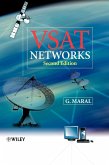Pablo Tapia, Jun Liu, Yasmin Karimli, Martin FeuersteinA Practical Perspective
Hspa Performance and Evolution
A Practical Perspective
By Pablo Tapia, Jun Liu, Yasmin Karimli et al.
Pablo Tapia, Jun Liu, Yasmin Karimli, Martin FeuersteinA Practical Perspective
Hspa Performance and Evolution
A Practical Perspective
By Pablo Tapia, Jun Liu, Yasmin Karimli et al.
- Gebundenes Buch
- Merkliste
- Auf die Merkliste
- Bewerten Bewerten
- Teilen
- Produkt teilen
- Produkterinnerung
- Produkterinnerung
Written from an operator's viewpoint, HSPA Performance and Evolution explores the lessons learned and techniques developed for optimally deploying HSPA (High Speed Packet Access). The essential distinctions between rolling out HSPA compared to earlier UMTS and GSM technologies are explained covering the many issues that must be specifically handled. Areas in standards which have been left open for interpretation, causing significant differences between vendor implementations, are identified and solutions explored.
This book is invaluable in enabling wireless operators to extract maximum…mehr
Andere Kunden interessierten sich auch für
![HSPA+ Evolution to Release 12 HSPA+ Evolution to Release 12]() HSPA+ Evolution to Release 12102,99 €
HSPA+ Evolution to Release 12102,99 €![Antennas for Portable Devices Antennas for Portable Devices]() Zhi Ning Chen (ed.)Antennas for Portable Devices134,99 €
Zhi Ning Chen (ed.)Antennas for Portable Devices134,99 €![Vsat Networks Vsat Networks]() Gerard MaralVsat Networks174,99 €
Gerard MaralVsat Networks174,99 €![Digital Microwave Communication Digital Microwave Communication]() George KizerDigital Microwave Communication155,99 €
George KizerDigital Microwave Communication155,99 €![Conformal Array Antenna Theory and Design Conformal Array Antenna Theory and Design]() Lars JoseffssonConformal Array Antenna Theory and Design171,99 €
Lars JoseffssonConformal Array Antenna Theory and Design171,99 €![Adaptive Antennas for Wireless Communications Adaptive Antennas for Wireless Communications]() George V. Tsoulos (Hrsg.)Adaptive Antennas for Wireless Communications254,99 €
George V. Tsoulos (Hrsg.)Adaptive Antennas for Wireless Communications254,99 €![Planar Antennas for Wireless Communications Planar Antennas for Wireless Communications]() Kin-Lu WongPlanar Antennas for Wireless Communications189,99 €
Kin-Lu WongPlanar Antennas for Wireless Communications189,99 €-
-
-
Written from an operator's viewpoint, HSPA Performance and Evolution explores the lessons learned and techniques developed for optimally deploying HSPA (High Speed Packet Access). The essential distinctions between rolling out HSPA compared to earlier UMTS and GSM technologies are explained covering the many issues that must be specifically handled. Areas in standards which have been left open for interpretation, causing significant differences between vendor implementations, are identified and solutions explored.
This book is invaluable in enabling wireless operators to extract maximum performance offered by 3GPP's HSPA radio technology, consisting of both downlink (HSDPA) and uplink (HSUPA) elements. It focuses on real-world performance, sharing practical implementation methods and tradeoffs for deploying, optimizing and maintaining networks using the HSPA air interface.
Examines algorithms, equipment and performance perspectives to identify and explain HSPA
Measures performance and sets network parameters for optimal tradeoffs
Presents results from practical and real-world network performances
Explores the evolution of HSPA technology into HSPA+ and eventually next generation LTE technologies
Hinweis: Dieser Artikel kann nur an eine deutsche Lieferadresse ausgeliefert werden.
This book is invaluable in enabling wireless operators to extract maximum performance offered by 3GPP's HSPA radio technology, consisting of both downlink (HSDPA) and uplink (HSUPA) elements. It focuses on real-world performance, sharing practical implementation methods and tradeoffs for deploying, optimizing and maintaining networks using the HSPA air interface.
Examines algorithms, equipment and performance perspectives to identify and explain HSPA
Measures performance and sets network parameters for optimal tradeoffs
Presents results from practical and real-world network performances
Explores the evolution of HSPA technology into HSPA+ and eventually next generation LTE technologies
Hinweis: Dieser Artikel kann nur an eine deutsche Lieferadresse ausgeliefert werden.
Produktdetails
- Produktdetails
- Verlag: Wiley & Sons
- 1. Auflage
- Seitenzahl: 284
- Erscheinungstermin: 1. Mai 2009
- Englisch
- Abmessung: 249mm x 173mm x 20mm
- Gewicht: 630g
- ISBN-13: 9780470699423
- ISBN-10: 0470699426
- Artikelnr.: 25626423
- Herstellerkennzeichnung
- Libri GmbH
- Europaallee 1
- 36244 Bad Hersfeld
- gpsr@libri.de
- Verlag: Wiley & Sons
- 1. Auflage
- Seitenzahl: 284
- Erscheinungstermin: 1. Mai 2009
- Englisch
- Abmessung: 249mm x 173mm x 20mm
- Gewicht: 630g
- ISBN-13: 9780470699423
- ISBN-10: 0470699426
- Artikelnr.: 25626423
- Herstellerkennzeichnung
- Libri GmbH
- Europaallee 1
- 36244 Bad Hersfeld
- gpsr@libri.de
Pablo Tapia is a Principal Engineer at T-Mobile, US. He delivers consultancy services to T-Mobile USA within the Network Evolution and Strategy Group at T-Mobile Headquarters, working closely with Nokia and Ericsson. Before moving to the US he was Lead Consultant at Optimi in Spain, where he supplied T-Mobile International (15+ operators) with a corporate solution for WCDMA Optimization, including RF planning and optimization. Previous to this he set up Nokia Networks R&D center in China. He has a multidisciplinary background, including experience in R&D in network vendors, software development and operator experience, with contribution to multiple papers, and co-designer of several patents. He is a contributor to two Wiley books. Jun Liu is also a Principal Engineer at T-Mobile, US. He has co-authored a number of papers with Pablo Tapia.
Figures and Tables.
About the Authors.
Preface.
Foreword.
Acknowledgements.
1 Introduction.
1.1 Services and Applications for HSPA.
1.2 Organization of the Book.
References.
2 Overview of UMTS/HSPA Systems.
2.1 UMTS: GSM Evolution to 3G Networks.
2.1.1 Overview of UMTS Standardization.
2.1.2 UMTS Network Architecture.
2.1.3 Air Interface Technology.
2.2 UMTS System Elements.
2.2.1 User Equipment (UE).
2.2.2 Node-B.
2.2.3 Radio Network Controller (RNC).
2.3 UMTS Radio Bearers and Services.
2.3.1 Information Transfer Attributes.
2.3.2 Quality of Service (QoS) Attributes.
2.4 HSDPA (High Speed Downlink Packet Access).
2.4.1 Motivation for the Introduction of HSDPA.
2.4.2 Main HSDPA Features.
2.5 HSUPA (High Speed Uplink Packet Access).
2.5.1 Main HSUPA Features.
2.6 Summary.
References.
3 Applications and Quality of Service in HSPA Networks.
3.1 Application Performance Requirements.
3.1.1 The Role of Latency in End-user Performance.
3.1.2 Considerations of TCP/IP.
3.1.3 Typical Application Profiles.
3.2 Support of QoS in HSPA Networks.
3.2.1 3GPP QoS Attributes.
3.2.2 Negotiation of QoS Attributes.
3.2.3 QoS Modification for HSPA.
3.3 Summary.
References.
4 Radio Resource Management in UMTS/HSPA Networks.
4.1 Admission and Congestion Control.
4.1.1 Management of Transmit Power Resources.
4.1.2 Management of Channelization Codes.
4.2 Packet Scheduler.
4.2.1 HSDPA Scheduling.
4.2.2 HSUPA Scheduling.
4.3 HSDPA Power Allocation.
4.4 Power Control and Link Adaptation.
4.4.1 Power Control.
4.4.2 Link Adaptation.
4.5 Mobility Management.
4.5.1 HSDPA Mobility Management.
4.5.2 HSUPA Mobility Management.
4.6 Summary.
References.
5 HSPA Radio Network Planning and Optimization.
5.1 Key Differences Between HSPA and Legacy Rel.'99 Channels.
5.1.1 HSPA Data User Behavior Compared to Rel.'99 Voice Users.
5.1.2 HSPA Radio Performance Considerations Compared to Rel.'99.
5.1.3 HSPA Mobility Considerations Compared to Rel.'99.
5.1.4 HSPA Baseband and Backhaul Resource Considerations Compared to
Rel.'99.
5.2 Link Budget Analysis.
5.2.1 Link Budget Methodology.
5.2.2 Downlink Analysis.
5.2.3 Uplink Link Budget Analysis.
5.3 Overview of System Level Simulations.
5.4 Cell Planning Process.
5.4.1 Practical Rules for UMTS/HSPA Cell Planning.
5.4.2 Automate Cell Planning (ACP) Tool Usage.
5.4.3 Deployment of ACP Network Configuration.
5.5 Optimization with Drive Test Tools.
5.6 Main Radio Parameters Affecting HSPA Performance.
5.6.1 Basic Activation Features.
5.6.2 Control of Resources.
5.6.3 Mobility Management Parameters.
5.6.4 Performance Parameters .
5.7 Dynamic Network Optimization (DNO) Tools.
5.7.1 Collection of Relevant Network Information.
5.7.2 Identification of Parameters for DNO.
5.7.3 Definition of the DNO Strategy.
5.8 Summary.
References.
6 HSPA Radio Performance.
6.1 HSDPA Lab Performance Evaluation.
6.1.1 Lab Setup.
6.1.2 Basic Functionality Testing.
6.1.3 HSDPA Latency Improvement.
6.1.4 HSDPA Throughput and Link Performance.
6.1.5 HSDPA Link Adaptation Performance.
6.1.6 Dynamic Power Allocation.
6.1.7 HSDPA Scheduler Performance.
6.2 HSUPA Lab Performance Evaluation.
6.2.1 Throughput Performance.
6.2.2 Scheduler Performance.
6.2.3 Latency Performance.
6.2.4 Mixed Voice and HSUPA Performance.
6.3 Field Evaluation.
6.3.1 Field Network Configurations.
6.3.2 HSDPA Performance.
6.3.3 HSUPA Performance.
6.4 Other Performance Considerations.
6.4.1 Terminal Device Performance.
6.4.2 Infrastructure Performance.
6.4.3 Application Performance.
6.5 Summary.
References.
7 Capacity Growth Management.
7.1 UMTS/HSPA Carrier Deployment Strategy.
7.1.1 Factors Affecting the Carrier Planning Strategy.
7.1.2 Voice and HSPA on One Carrier.
7.1.3 Data Centric Carrier.
7.1.4 Factors Affecting the Shared vs. Data Centric Carrier Decision.
7.2 Data Traffic Profiling and Network Dimensioning.
7.2.1 Traffic Profiling.
7.2.2 Data Traffic Models.
7.2.3 Data Traffic Modeling Case Study.
7.3 Summary.
References.
8 HSPA Evolution (HSPA+).
8.1 Standards Evolution.
8.1.1 Radio Evolution.
8.1.2 Architecture Evolution.
8.1.3 Vendor Ecosystem.
8.2 HSPA+ Radio Enhancements.
8.2.1 MIMO.
8.2.2 Higher Order Modulation (HOM).
8.2.3 Advanced Receivers.
8.2.4 Continuous Packet Connectivity (CPC).
8.2.5 Circuit-switched Voice Over HSPA.
8.2.6 Dual Carrier Operation in HSDPA.
8.3 Architecture Evolution.
8.3.1 GPRS Flat Architecture.
8.3.2 End-to-end Quality of Service (QoS) Architecture.
8.4 Converged Voice and Data Networks: VoIP.
8.4.1 Benefits of an All-IP Network.
8.4.2 Fundamentals of Voice over IP (VoIP).
8.4.3 Requirements for VoIP as a Complete Voice Service.
8.4.4 HSPA Enablers for Voice Over IP.
8.4.5 Performance of VoIP in HSPA Networks.
8.5 Summary.
References.
9 Technology Strategy Beyond HSPA.
9.1 Introduction to Evolved UTRAN.
9.1.1 Technology Choice and Key Features.
9.1.2 Architecture and Interfaces.
9.1.3 Early LTE Trials.
9.2 Analysis of HSPA vs. LTE.
9.2.1 Performance Comparison of LTE vs. HSPA Rel.'6.
9.2.2 Performance Comparison of LTE vs. HSPA+.
9.3 LTE Deployment and Migration Scenarios.
9.3.1 Technology Timelines.
9.3.2 Key Factors for New Technology Overlay.
9.3.3 HSPA and LTE Overlay Scenarios.
9.4 Summary.
References.
Index.
About the Authors.
Preface.
Foreword.
Acknowledgements.
1 Introduction.
1.1 Services and Applications for HSPA.
1.2 Organization of the Book.
References.
2 Overview of UMTS/HSPA Systems.
2.1 UMTS: GSM Evolution to 3G Networks.
2.1.1 Overview of UMTS Standardization.
2.1.2 UMTS Network Architecture.
2.1.3 Air Interface Technology.
2.2 UMTS System Elements.
2.2.1 User Equipment (UE).
2.2.2 Node-B.
2.2.3 Radio Network Controller (RNC).
2.3 UMTS Radio Bearers and Services.
2.3.1 Information Transfer Attributes.
2.3.2 Quality of Service (QoS) Attributes.
2.4 HSDPA (High Speed Downlink Packet Access).
2.4.1 Motivation for the Introduction of HSDPA.
2.4.2 Main HSDPA Features.
2.5 HSUPA (High Speed Uplink Packet Access).
2.5.1 Main HSUPA Features.
2.6 Summary.
References.
3 Applications and Quality of Service in HSPA Networks.
3.1 Application Performance Requirements.
3.1.1 The Role of Latency in End-user Performance.
3.1.2 Considerations of TCP/IP.
3.1.3 Typical Application Profiles.
3.2 Support of QoS in HSPA Networks.
3.2.1 3GPP QoS Attributes.
3.2.2 Negotiation of QoS Attributes.
3.2.3 QoS Modification for HSPA.
3.3 Summary.
References.
4 Radio Resource Management in UMTS/HSPA Networks.
4.1 Admission and Congestion Control.
4.1.1 Management of Transmit Power Resources.
4.1.2 Management of Channelization Codes.
4.2 Packet Scheduler.
4.2.1 HSDPA Scheduling.
4.2.2 HSUPA Scheduling.
4.3 HSDPA Power Allocation.
4.4 Power Control and Link Adaptation.
4.4.1 Power Control.
4.4.2 Link Adaptation.
4.5 Mobility Management.
4.5.1 HSDPA Mobility Management.
4.5.2 HSUPA Mobility Management.
4.6 Summary.
References.
5 HSPA Radio Network Planning and Optimization.
5.1 Key Differences Between HSPA and Legacy Rel.'99 Channels.
5.1.1 HSPA Data User Behavior Compared to Rel.'99 Voice Users.
5.1.2 HSPA Radio Performance Considerations Compared to Rel.'99.
5.1.3 HSPA Mobility Considerations Compared to Rel.'99.
5.1.4 HSPA Baseband and Backhaul Resource Considerations Compared to
Rel.'99.
5.2 Link Budget Analysis.
5.2.1 Link Budget Methodology.
5.2.2 Downlink Analysis.
5.2.3 Uplink Link Budget Analysis.
5.3 Overview of System Level Simulations.
5.4 Cell Planning Process.
5.4.1 Practical Rules for UMTS/HSPA Cell Planning.
5.4.2 Automate Cell Planning (ACP) Tool Usage.
5.4.3 Deployment of ACP Network Configuration.
5.5 Optimization with Drive Test Tools.
5.6 Main Radio Parameters Affecting HSPA Performance.
5.6.1 Basic Activation Features.
5.6.2 Control of Resources.
5.6.3 Mobility Management Parameters.
5.6.4 Performance Parameters .
5.7 Dynamic Network Optimization (DNO) Tools.
5.7.1 Collection of Relevant Network Information.
5.7.2 Identification of Parameters for DNO.
5.7.3 Definition of the DNO Strategy.
5.8 Summary.
References.
6 HSPA Radio Performance.
6.1 HSDPA Lab Performance Evaluation.
6.1.1 Lab Setup.
6.1.2 Basic Functionality Testing.
6.1.3 HSDPA Latency Improvement.
6.1.4 HSDPA Throughput and Link Performance.
6.1.5 HSDPA Link Adaptation Performance.
6.1.6 Dynamic Power Allocation.
6.1.7 HSDPA Scheduler Performance.
6.2 HSUPA Lab Performance Evaluation.
6.2.1 Throughput Performance.
6.2.2 Scheduler Performance.
6.2.3 Latency Performance.
6.2.4 Mixed Voice and HSUPA Performance.
6.3 Field Evaluation.
6.3.1 Field Network Configurations.
6.3.2 HSDPA Performance.
6.3.3 HSUPA Performance.
6.4 Other Performance Considerations.
6.4.1 Terminal Device Performance.
6.4.2 Infrastructure Performance.
6.4.3 Application Performance.
6.5 Summary.
References.
7 Capacity Growth Management.
7.1 UMTS/HSPA Carrier Deployment Strategy.
7.1.1 Factors Affecting the Carrier Planning Strategy.
7.1.2 Voice and HSPA on One Carrier.
7.1.3 Data Centric Carrier.
7.1.4 Factors Affecting the Shared vs. Data Centric Carrier Decision.
7.2 Data Traffic Profiling and Network Dimensioning.
7.2.1 Traffic Profiling.
7.2.2 Data Traffic Models.
7.2.3 Data Traffic Modeling Case Study.
7.3 Summary.
References.
8 HSPA Evolution (HSPA+).
8.1 Standards Evolution.
8.1.1 Radio Evolution.
8.1.2 Architecture Evolution.
8.1.3 Vendor Ecosystem.
8.2 HSPA+ Radio Enhancements.
8.2.1 MIMO.
8.2.2 Higher Order Modulation (HOM).
8.2.3 Advanced Receivers.
8.2.4 Continuous Packet Connectivity (CPC).
8.2.5 Circuit-switched Voice Over HSPA.
8.2.6 Dual Carrier Operation in HSDPA.
8.3 Architecture Evolution.
8.3.1 GPRS Flat Architecture.
8.3.2 End-to-end Quality of Service (QoS) Architecture.
8.4 Converged Voice and Data Networks: VoIP.
8.4.1 Benefits of an All-IP Network.
8.4.2 Fundamentals of Voice over IP (VoIP).
8.4.3 Requirements for VoIP as a Complete Voice Service.
8.4.4 HSPA Enablers for Voice Over IP.
8.4.5 Performance of VoIP in HSPA Networks.
8.5 Summary.
References.
9 Technology Strategy Beyond HSPA.
9.1 Introduction to Evolved UTRAN.
9.1.1 Technology Choice and Key Features.
9.1.2 Architecture and Interfaces.
9.1.3 Early LTE Trials.
9.2 Analysis of HSPA vs. LTE.
9.2.1 Performance Comparison of LTE vs. HSPA Rel.'6.
9.2.2 Performance Comparison of LTE vs. HSPA+.
9.3 LTE Deployment and Migration Scenarios.
9.3.1 Technology Timelines.
9.3.2 Key Factors for New Technology Overlay.
9.3.3 HSPA and LTE Overlay Scenarios.
9.4 Summary.
References.
Index.
Figures and Tables.
About the Authors.
Preface.
Foreword.
Acknowledgements.
1 Introduction.
1.1 Services and Applications for HSPA.
1.2 Organization of the Book.
References.
2 Overview of UMTS/HSPA Systems.
2.1 UMTS: GSM Evolution to 3G Networks.
2.1.1 Overview of UMTS Standardization.
2.1.2 UMTS Network Architecture.
2.1.3 Air Interface Technology.
2.2 UMTS System Elements.
2.2.1 User Equipment (UE).
2.2.2 Node-B.
2.2.3 Radio Network Controller (RNC).
2.3 UMTS Radio Bearers and Services.
2.3.1 Information Transfer Attributes.
2.3.2 Quality of Service (QoS) Attributes.
2.4 HSDPA (High Speed Downlink Packet Access).
2.4.1 Motivation for the Introduction of HSDPA.
2.4.2 Main HSDPA Features.
2.5 HSUPA (High Speed Uplink Packet Access).
2.5.1 Main HSUPA Features.
2.6 Summary.
References.
3 Applications and Quality of Service in HSPA Networks.
3.1 Application Performance Requirements.
3.1.1 The Role of Latency in End-user Performance.
3.1.2 Considerations of TCP/IP.
3.1.3 Typical Application Profiles.
3.2 Support of QoS in HSPA Networks.
3.2.1 3GPP QoS Attributes.
3.2.2 Negotiation of QoS Attributes.
3.2.3 QoS Modification for HSPA.
3.3 Summary.
References.
4 Radio Resource Management in UMTS/HSPA Networks.
4.1 Admission and Congestion Control.
4.1.1 Management of Transmit Power Resources.
4.1.2 Management of Channelization Codes.
4.2 Packet Scheduler.
4.2.1 HSDPA Scheduling.
4.2.2 HSUPA Scheduling.
4.3 HSDPA Power Allocation.
4.4 Power Control and Link Adaptation.
4.4.1 Power Control.
4.4.2 Link Adaptation.
4.5 Mobility Management.
4.5.1 HSDPA Mobility Management.
4.5.2 HSUPA Mobility Management.
4.6 Summary.
References.
5 HSPA Radio Network Planning and Optimization.
5.1 Key Differences Between HSPA and Legacy Rel.'99 Channels.
5.1.1 HSPA Data User Behavior Compared to Rel.'99 Voice Users.
5.1.2 HSPA Radio Performance Considerations Compared to Rel.'99.
5.1.3 HSPA Mobility Considerations Compared to Rel.'99.
5.1.4 HSPA Baseband and Backhaul Resource Considerations Compared to
Rel.'99.
5.2 Link Budget Analysis.
5.2.1 Link Budget Methodology.
5.2.2 Downlink Analysis.
5.2.3 Uplink Link Budget Analysis.
5.3 Overview of System Level Simulations.
5.4 Cell Planning Process.
5.4.1 Practical Rules for UMTS/HSPA Cell Planning.
5.4.2 Automate Cell Planning (ACP) Tool Usage.
5.4.3 Deployment of ACP Network Configuration.
5.5 Optimization with Drive Test Tools.
5.6 Main Radio Parameters Affecting HSPA Performance.
5.6.1 Basic Activation Features.
5.6.2 Control of Resources.
5.6.3 Mobility Management Parameters.
5.6.4 Performance Parameters .
5.7 Dynamic Network Optimization (DNO) Tools.
5.7.1 Collection of Relevant Network Information.
5.7.2 Identification of Parameters for DNO.
5.7.3 Definition of the DNO Strategy.
5.8 Summary.
References.
6 HSPA Radio Performance.
6.1 HSDPA Lab Performance Evaluation.
6.1.1 Lab Setup.
6.1.2 Basic Functionality Testing.
6.1.3 HSDPA Latency Improvement.
6.1.4 HSDPA Throughput and Link Performance.
6.1.5 HSDPA Link Adaptation Performance.
6.1.6 Dynamic Power Allocation.
6.1.7 HSDPA Scheduler Performance.
6.2 HSUPA Lab Performance Evaluation.
6.2.1 Throughput Performance.
6.2.2 Scheduler Performance.
6.2.3 Latency Performance.
6.2.4 Mixed Voice and HSUPA Performance.
6.3 Field Evaluation.
6.3.1 Field Network Configurations.
6.3.2 HSDPA Performance.
6.3.3 HSUPA Performance.
6.4 Other Performance Considerations.
6.4.1 Terminal Device Performance.
6.4.2 Infrastructure Performance.
6.4.3 Application Performance.
6.5 Summary.
References.
7 Capacity Growth Management.
7.1 UMTS/HSPA Carrier Deployment Strategy.
7.1.1 Factors Affecting the Carrier Planning Strategy.
7.1.2 Voice and HSPA on One Carrier.
7.1.3 Data Centric Carrier.
7.1.4 Factors Affecting the Shared vs. Data Centric Carrier Decision.
7.2 Data Traffic Profiling and Network Dimensioning.
7.2.1 Traffic Profiling.
7.2.2 Data Traffic Models.
7.2.3 Data Traffic Modeling Case Study.
7.3 Summary.
References.
8 HSPA Evolution (HSPA+).
8.1 Standards Evolution.
8.1.1 Radio Evolution.
8.1.2 Architecture Evolution.
8.1.3 Vendor Ecosystem.
8.2 HSPA+ Radio Enhancements.
8.2.1 MIMO.
8.2.2 Higher Order Modulation (HOM).
8.2.3 Advanced Receivers.
8.2.4 Continuous Packet Connectivity (CPC).
8.2.5 Circuit-switched Voice Over HSPA.
8.2.6 Dual Carrier Operation in HSDPA.
8.3 Architecture Evolution.
8.3.1 GPRS Flat Architecture.
8.3.2 End-to-end Quality of Service (QoS) Architecture.
8.4 Converged Voice and Data Networks: VoIP.
8.4.1 Benefits of an All-IP Network.
8.4.2 Fundamentals of Voice over IP (VoIP).
8.4.3 Requirements for VoIP as a Complete Voice Service.
8.4.4 HSPA Enablers for Voice Over IP.
8.4.5 Performance of VoIP in HSPA Networks.
8.5 Summary.
References.
9 Technology Strategy Beyond HSPA.
9.1 Introduction to Evolved UTRAN.
9.1.1 Technology Choice and Key Features.
9.1.2 Architecture and Interfaces.
9.1.3 Early LTE Trials.
9.2 Analysis of HSPA vs. LTE.
9.2.1 Performance Comparison of LTE vs. HSPA Rel.'6.
9.2.2 Performance Comparison of LTE vs. HSPA+.
9.3 LTE Deployment and Migration Scenarios.
9.3.1 Technology Timelines.
9.3.2 Key Factors for New Technology Overlay.
9.3.3 HSPA and LTE Overlay Scenarios.
9.4 Summary.
References.
Index.
About the Authors.
Preface.
Foreword.
Acknowledgements.
1 Introduction.
1.1 Services and Applications for HSPA.
1.2 Organization of the Book.
References.
2 Overview of UMTS/HSPA Systems.
2.1 UMTS: GSM Evolution to 3G Networks.
2.1.1 Overview of UMTS Standardization.
2.1.2 UMTS Network Architecture.
2.1.3 Air Interface Technology.
2.2 UMTS System Elements.
2.2.1 User Equipment (UE).
2.2.2 Node-B.
2.2.3 Radio Network Controller (RNC).
2.3 UMTS Radio Bearers and Services.
2.3.1 Information Transfer Attributes.
2.3.2 Quality of Service (QoS) Attributes.
2.4 HSDPA (High Speed Downlink Packet Access).
2.4.1 Motivation for the Introduction of HSDPA.
2.4.2 Main HSDPA Features.
2.5 HSUPA (High Speed Uplink Packet Access).
2.5.1 Main HSUPA Features.
2.6 Summary.
References.
3 Applications and Quality of Service in HSPA Networks.
3.1 Application Performance Requirements.
3.1.1 The Role of Latency in End-user Performance.
3.1.2 Considerations of TCP/IP.
3.1.3 Typical Application Profiles.
3.2 Support of QoS in HSPA Networks.
3.2.1 3GPP QoS Attributes.
3.2.2 Negotiation of QoS Attributes.
3.2.3 QoS Modification for HSPA.
3.3 Summary.
References.
4 Radio Resource Management in UMTS/HSPA Networks.
4.1 Admission and Congestion Control.
4.1.1 Management of Transmit Power Resources.
4.1.2 Management of Channelization Codes.
4.2 Packet Scheduler.
4.2.1 HSDPA Scheduling.
4.2.2 HSUPA Scheduling.
4.3 HSDPA Power Allocation.
4.4 Power Control and Link Adaptation.
4.4.1 Power Control.
4.4.2 Link Adaptation.
4.5 Mobility Management.
4.5.1 HSDPA Mobility Management.
4.5.2 HSUPA Mobility Management.
4.6 Summary.
References.
5 HSPA Radio Network Planning and Optimization.
5.1 Key Differences Between HSPA and Legacy Rel.'99 Channels.
5.1.1 HSPA Data User Behavior Compared to Rel.'99 Voice Users.
5.1.2 HSPA Radio Performance Considerations Compared to Rel.'99.
5.1.3 HSPA Mobility Considerations Compared to Rel.'99.
5.1.4 HSPA Baseband and Backhaul Resource Considerations Compared to
Rel.'99.
5.2 Link Budget Analysis.
5.2.1 Link Budget Methodology.
5.2.2 Downlink Analysis.
5.2.3 Uplink Link Budget Analysis.
5.3 Overview of System Level Simulations.
5.4 Cell Planning Process.
5.4.1 Practical Rules for UMTS/HSPA Cell Planning.
5.4.2 Automate Cell Planning (ACP) Tool Usage.
5.4.3 Deployment of ACP Network Configuration.
5.5 Optimization with Drive Test Tools.
5.6 Main Radio Parameters Affecting HSPA Performance.
5.6.1 Basic Activation Features.
5.6.2 Control of Resources.
5.6.3 Mobility Management Parameters.
5.6.4 Performance Parameters .
5.7 Dynamic Network Optimization (DNO) Tools.
5.7.1 Collection of Relevant Network Information.
5.7.2 Identification of Parameters for DNO.
5.7.3 Definition of the DNO Strategy.
5.8 Summary.
References.
6 HSPA Radio Performance.
6.1 HSDPA Lab Performance Evaluation.
6.1.1 Lab Setup.
6.1.2 Basic Functionality Testing.
6.1.3 HSDPA Latency Improvement.
6.1.4 HSDPA Throughput and Link Performance.
6.1.5 HSDPA Link Adaptation Performance.
6.1.6 Dynamic Power Allocation.
6.1.7 HSDPA Scheduler Performance.
6.2 HSUPA Lab Performance Evaluation.
6.2.1 Throughput Performance.
6.2.2 Scheduler Performance.
6.2.3 Latency Performance.
6.2.4 Mixed Voice and HSUPA Performance.
6.3 Field Evaluation.
6.3.1 Field Network Configurations.
6.3.2 HSDPA Performance.
6.3.3 HSUPA Performance.
6.4 Other Performance Considerations.
6.4.1 Terminal Device Performance.
6.4.2 Infrastructure Performance.
6.4.3 Application Performance.
6.5 Summary.
References.
7 Capacity Growth Management.
7.1 UMTS/HSPA Carrier Deployment Strategy.
7.1.1 Factors Affecting the Carrier Planning Strategy.
7.1.2 Voice and HSPA on One Carrier.
7.1.3 Data Centric Carrier.
7.1.4 Factors Affecting the Shared vs. Data Centric Carrier Decision.
7.2 Data Traffic Profiling and Network Dimensioning.
7.2.1 Traffic Profiling.
7.2.2 Data Traffic Models.
7.2.3 Data Traffic Modeling Case Study.
7.3 Summary.
References.
8 HSPA Evolution (HSPA+).
8.1 Standards Evolution.
8.1.1 Radio Evolution.
8.1.2 Architecture Evolution.
8.1.3 Vendor Ecosystem.
8.2 HSPA+ Radio Enhancements.
8.2.1 MIMO.
8.2.2 Higher Order Modulation (HOM).
8.2.3 Advanced Receivers.
8.2.4 Continuous Packet Connectivity (CPC).
8.2.5 Circuit-switched Voice Over HSPA.
8.2.6 Dual Carrier Operation in HSDPA.
8.3 Architecture Evolution.
8.3.1 GPRS Flat Architecture.
8.3.2 End-to-end Quality of Service (QoS) Architecture.
8.4 Converged Voice and Data Networks: VoIP.
8.4.1 Benefits of an All-IP Network.
8.4.2 Fundamentals of Voice over IP (VoIP).
8.4.3 Requirements for VoIP as a Complete Voice Service.
8.4.4 HSPA Enablers for Voice Over IP.
8.4.5 Performance of VoIP in HSPA Networks.
8.5 Summary.
References.
9 Technology Strategy Beyond HSPA.
9.1 Introduction to Evolved UTRAN.
9.1.1 Technology Choice and Key Features.
9.1.2 Architecture and Interfaces.
9.1.3 Early LTE Trials.
9.2 Analysis of HSPA vs. LTE.
9.2.1 Performance Comparison of LTE vs. HSPA Rel.'6.
9.2.2 Performance Comparison of LTE vs. HSPA+.
9.3 LTE Deployment and Migration Scenarios.
9.3.1 Technology Timelines.
9.3.2 Key Factors for New Technology Overlay.
9.3.3 HSPA and LTE Overlay Scenarios.
9.4 Summary.
References.
Index.








